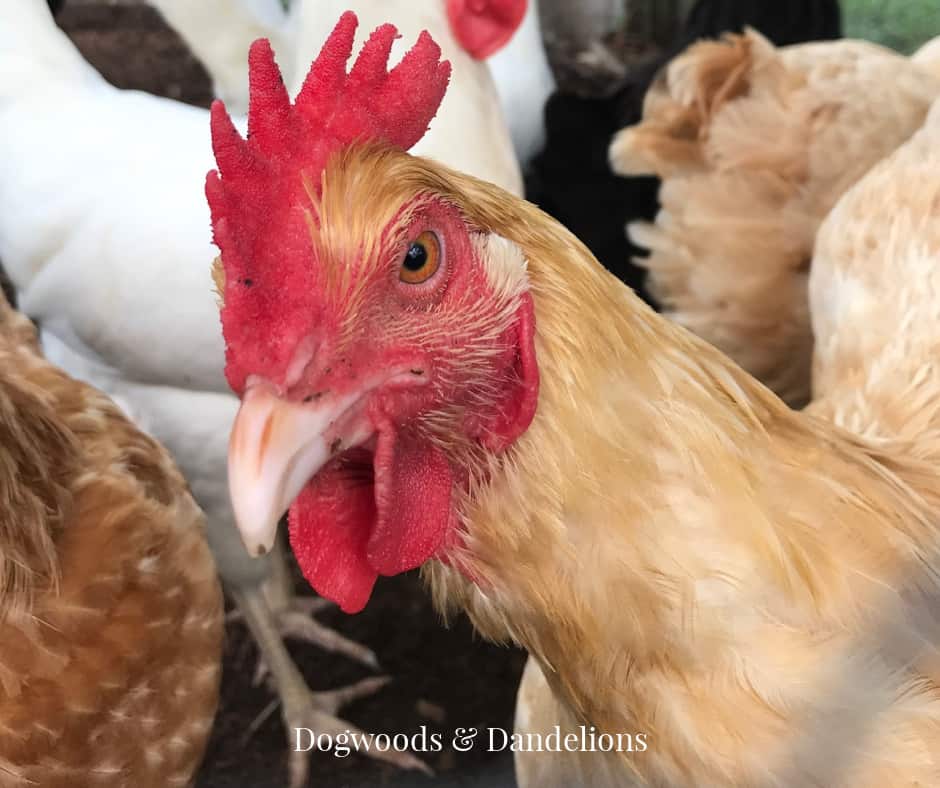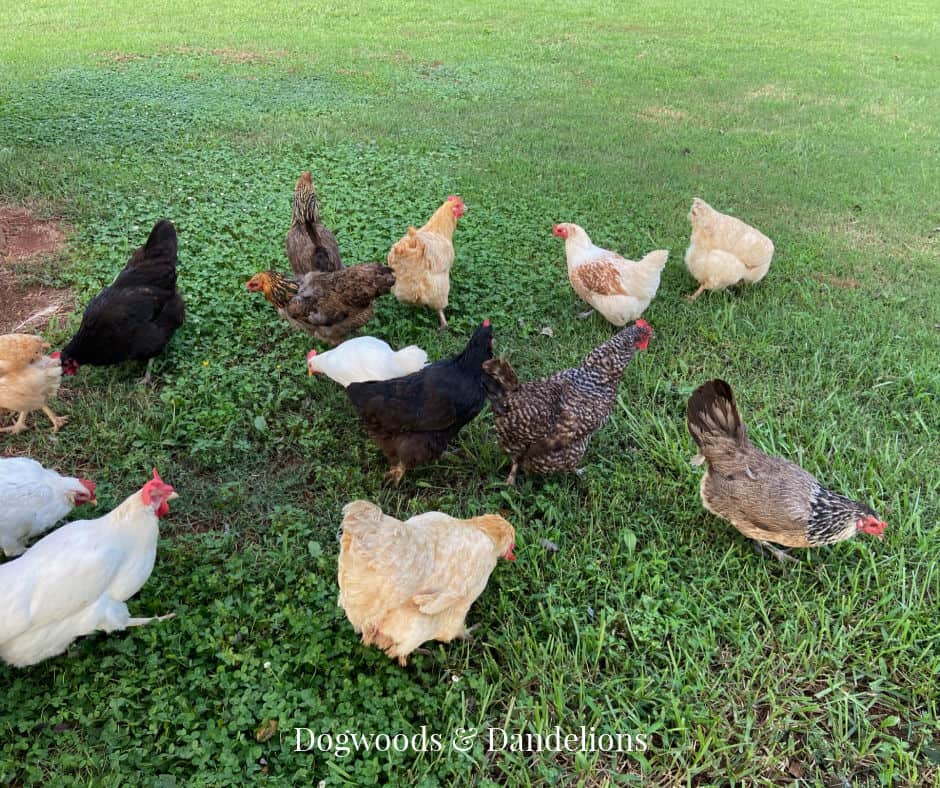Combining Two Flocks of Chickens (without Bloodshed)
Inside: Combining two flocks of chickens can be stressful for both the chickens and the chicken owners. Here are some ways to make the process of merging two flocks together easier on everyone.
You bought new chicks this spring and now it’s time to combine them with your older flock of chickens. How can you accomplish this without too much drama? Read on to see several strategies for minimizing bloodshed in the coop when merging two flocks of chicken into one.
Is There Really A Pecking Order?
First things first. Let’s talk pecking order. Pecking order is a real thing. There will always be leaders and there will always be followers.
When you try to put new chickens in with other chickens, there is going to be a shift in the pecking order. The older hens may feel threatened by the new girls and the new girls will probably be scared of the older chickens and unsure of their new environment.
You will likely have a few squabbles in the first week or two as the adult birds fight for positions and create a new pecking order.

Affiliate Disclosure: Please note that some of the links in this article may be affiliate links and I may receive a small commission if you purchase something through a link. It will not change your cost. As an Amazon Associate, I earn from qualifying purchases. For more information, see my disclosures page.)
When is the Best Time to Combing Two Flocks
If you are combining young chickens with older hens, they should all be about the same size. Otherwise, the smaller ones will get picked on.
It is best to wait until at least 16 weeks of age before adding new baby chicks to the rest of your flock. By this time, they should be similar in size and the new flock should be better able to defend themselves from the mature chickens.
Remember, merging two flocks will disrupt the established pecking order of BOTH flocks. Many times the new girls will end up at the bottom of the pecking order.
How to Merge the Two Flocks of Chickens
Combining two flocks of chickens is not as simple as putting everyone together and expecting things to go smoothly. You need to allow time for the older birds to get used to the new chickens.
The process below is how we have successfully merged our new pullets with our older chickens every year.
First, try to allow the mature birds and the young chickens to see one another for a week or more without actually being able to get to each other.
The next step is to separate the two flocks with a fence or something similar so they can be near each other but can’t physically touch. We move our chicken tractor next to our permanent coop for this stage.
After a week or so, put the two flocks together where they will be residing, but still keep the two flocks separated. A large dog crate in the coop is ideal for this.
If that isn’t an option, fencing a section of the existing coop or run with chicken wire for the young chickens will work too. Basically, you are just creating a separate pen for the young chicks. Be sure that the existing flock members have enough space to roam.
Also remember that all the chickens should have access to food, water, shelter, and a safe place to sleep.
Since we don’t have a pet crate, we fence off part of our run and add a dog house for the young birds to sleep in. Allow another week for this part of the process.

Combining the Flocks With No Barriers
When you are ready to finally put all the chickens together, open the pet crate or remove the fencing between them. It’s a good idea to keep a close eye on the entire flock during this time, especially for the first day or two.
Don’t combine the two flocks and then run off to work leaving them alone for 8 to 10 hours without supervision. You are likely to come home to chickens with severe injuries or even worse.
Ideally, you should put them together on a day when you can be home to monitor their behavior. Have a spray bottle of water handy. (Set it to “stream.”) A water gun will also work.
If you see one chicken bullying another, you can shoot a stream of water at the chicken to discourage the pecking behavior. The water will not injure the chickens but it is enough to startle them to stop their bad behavior.
Want to learn more about raising backyard chicks? Get my free Chick-Raising Success Guide with 3 things you need to know to raise baby chicks (and none of the things you don’t!).
Monitor your chickens for serious injuries. If any have open wounds, they need to be removed immediately.
However, if you have one particular hen (or rooster) that is being a bully, remove the bully. Keep the bully away in a separate enclosure for 5 to 7 days.
This will usually result in a shift in the pecking order and the bully will be more worried about his/her position in the flock instead of picking on the new chickens.
Read more: How to Deal With a Bully Chicken
You may want to leave the pet crate or dog house in the chicken coop or run for another week or so to allow everyone to get used to their new home. This gives the new birds a safe place to hide.
Once you remove the crate or dog house, be prepared to place some of the new chickens on the roosting bar at night. Sometimes it takes about 2 weeks for the chickens to figure out where to go to sleep. (But if they sleep on the floor of the coop, that’s OK too. They will eventually figure it out.)

Things to DO When Combining Two Flocks of Chickens
- Do allow time for the chickens to see each other without touching.
- Plan to allow several weeks to fully complete the integration process.
- Do be sure the chickens are about the same size. Otherwise fully grown chickens will bully younger chicks.
- If you are adding adult chickens from another farm, allow a quarantine period of at least a full month to be sure they aren’t showing any signs of disease that could infect the rest of the flock.
- If you let them free-range together, let the new flock into the area first to explore for a bit. Then allow the older ones into the area too. This gives the new ones time to feel more comfortable in the free-ranging area.
- Do let the two flocks into as large an area as possible. The more room they have, the easier the new chickens can get away from a mean chicken or find room to hide for a bit.
- Do use treats as a distraction. Throwing a handful of scratch or some kitchen scraps into the area can serve as a distraction for the more established flock.
- Do expect a drop in egg production when you merge the two flocks. This is a stressful time for both flocks, so naturally, your chickens will lay fewer eggs for a bit.
- Do provide multiple food and water stations. A bully will often try to keep the new flock away from food and water so providing multiple areas will make it much easier for the new chickens to get their nourishment.
Want to learn more about raising backyard chicks? Get my free Chick-Raising Success Guide with 3 things you need to know to raise baby chicks (and none of the things you don’t!).
Don’ts
- Don’t integrate baby chicks until they are the same size as the older flock members. If you are trying to introduce new chicks to an existing flock, the chicks should be at least 16 weeks old before merging the two.
- Don’t remove the chickens being bullied unless they have open wounds. It’s best to isolate the bully. If you remove the chicken that is being picked on, she/he will just have to start all over again when you try to add her/him back. And unfortunately, some of her/his current flock mates may try to bully her/him too.
- Don’t add the new flock to the existing flock and then leave them on their own for hours at a time. By the time you return, there could be serious blood shed or even death. Watch closely for the first few hours and every couple hours for the next few days.
- Don’t integrate just one bird. This is a recipe for disaster. They will gang up on her.
Combining two flocks of chickens can be done successfully but it will take a bit of patience and monitoring by the chicken owner. By keeping a close eye on the chickens, you will be able to spot problems quickly before they escalate into something serious.
Have you ever merged two flocks of chickens? What worked for you?

Meet Julie
I’m a farm girl born and bred in North Carolina. I’ve been growing a vegetable garden for over 20 years (and helping my Mom grow hers even longer). I’ve been raising chickens in my bathtub and backyard for 12+ years. I believe that homegrown food can be made simple. Let’s get started.
Related Posts
- How we use 2 coops to manage our flock.
- How to help your molting chickens.
- Preparing chickens for the winter.




Good article but we are adding three hens that are seven years old to our remaining 10 year old hen. We have our 20 Sq. ft. enclosure separated for our hen and the three new birds. We have divided up the roost so they share the space but can’t reach each other. There has been two episodes of pecking but we have stopped it. We have been doing this for just 3 days. In 12 days we leave for a trip for 2 weeks. What is your suggestion for handling the merge? So far the newbies are beginning to learn how to go up & roost but we have to help our girl get up to her side each night. our chicken sitter will let them out each morning, feed and pull ramp up at night. We’d hoped they’d be merged by two weeks so as to make it easy for all. Your advice would be appreciated.
I would just keep doing what you are doing. Hopefully, by the time you leave for your trip they will have sorted things out.
This is a timely article. I have 2 Orpington chickens and I’m adding 8 new Hyline hens to our free range flock. thankfully the coop is set up so I can block them completely from each other but they will be able to see each other while still keeping them completely seperate.
Thank you for letting me know. Sounds like you have the perfect space to add new hens. Enjoy your chickens and their delicious eggs!
I have two coops that share a run. I have done all the above. The new birds are in the larger coop. Can I put the old birds in larger coop with the new birds? There is not enough room in the smaller coop. Does it matter which coop they get migrated to?
You can definitely put the old birds in the larger coop. They just may take a bit longer to adjust to the move. And if they are laying right now, they will probably lay less eggs for a few weeks. You will probably need to block access to the other coop or they will naturally return there each night. Good luck.
I wish I read your article before I started introducing my 10-11 week old pullets to my existing flock. I put them at 8 weeks in a split run instead of splitting the coop because our coop design was not conducive for putting netting up or a dog crate big enough for 6. They needed more room till they got bigger. So now the hens and pullets are used to each other. They’ve free ranged together and spent time in the run together. Now I’m not sure how to get the pullets into the coop to sleep together with the hens.
Most likely the pullets will eventually go in the coop with the other hens. But to speed up the process, you might want to take them in each night just when it is getting dark and place them on the roost. The other option would be to lock everyone in the coop together for a week or so until they get used to it.